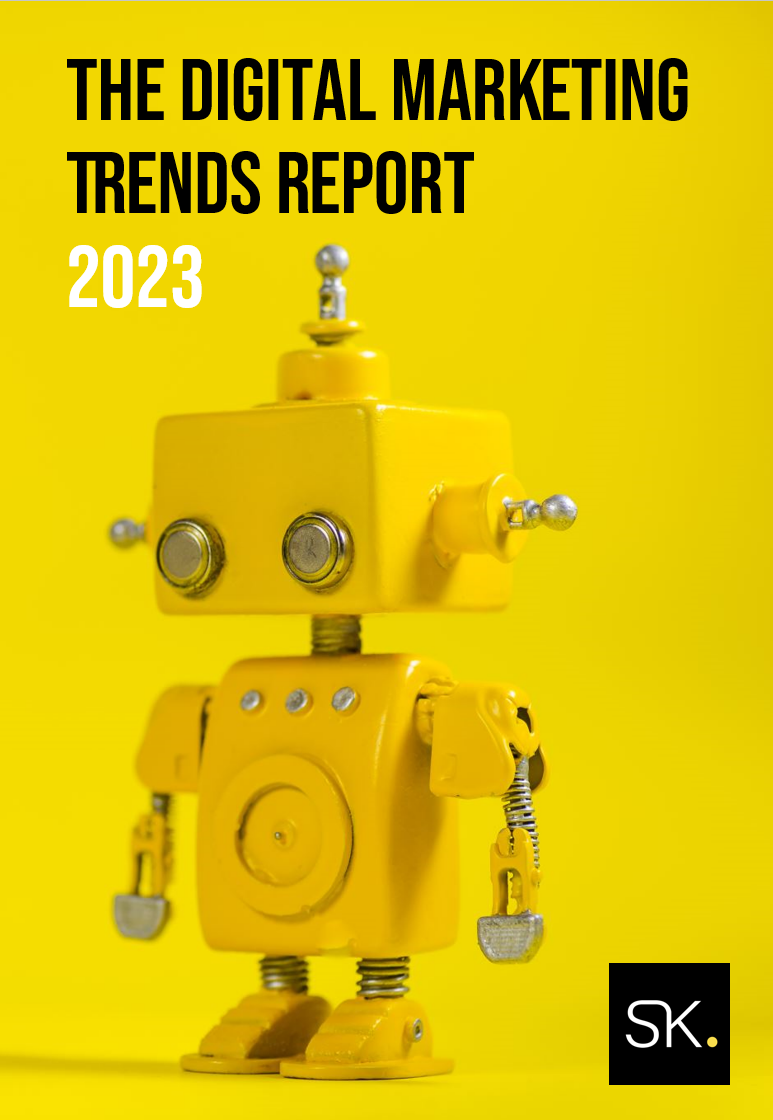We are finally waving goodbye to 2023 and looking forward to what the next year will bring. But what will 2024 mean for marketing? Here are the marketing trends that we predict will be vital to focus on next year.
AI – The Big Three
AI has changed marketing, content creation and tech in general since it exploded onto the scene in late 2022, and has shown no signs of stopping. While it has its limitations, AI tools have proven invaluable to marketers. In fact, 69% of businesses generate content by using AI tools like ChatGPT. However, AI tech is far from infallible and there are worries about misinformation and other issues.
The potential for AI use to result in data breaches is huge – people can and have shared private information with AI tools, which by no means keep it secret. Some are worried about job losses due to AI taking over some roles, and AI-fuelled automated decision-making may lead to issues such as discrimination and potential bias against certain groups.
Some consumers are worried about the effects of AI, such as being told the wrong information. They are right to be concerned – some political ads which may be considered propaganda have been generated using AI, and Meta has even banned AI-generated political content on their platform, although who knows how effective the ban will be.
Some consumers are still happy with the use of AI, with 65% surveyed saying they are willing to trust brands who use AI technology, as it could make customer experiences better. Almost two-thirds of consumers are also willing to use ChatGPT to find answers or info than a search engine like Google.
AI can also be used to great effect in personalising customer experiences through data-driven, highly targeted marketing campaigns. AI could help identify the needs and wants of customers so that brands can tailor their offerings even further. This could be implemented in real-life environments like shops and other retail spaces. Some may be concerned about data privacy, once again, but if handled correctly, it could be very effective for optimising advertising campaigns.
AI Chatbots
Chatbots are a clever use of AI tech that reduces the need for human customer service assistants, as AI can answer many customer queries. They can respond in real-time and talk just like a person would, thanks to natural language processing, or NLP.
Dominos made it even easier to summon a pizza online with their chatbot, which gives hungry consumers the chance to order a pizza without having to call anyone or download yet another app – they could do it all within a FB Messenger chat.
The internet operates 24/7 and consumers expect online businesses to be the same. That’s where AI chatbots can help. According to a survey, 38% of marketers have grand plans to implement chatbots in 2024. Some customer questions will need a response from an actual person, but a chatbot can deal with most messages from customers quickly and effectively.
AI content generation
Content generation is a huge part of AI use, with a whopping 61% of marketers currently relying on generative AI for their content needs. From blogs and articles to web content and social media posts, there’s a handy AI solution to the sheer amount of work that this requires. Github has even introduced an AI-powered developer tool called Copilot that uses GPT-3 to answer developers’ coding queries. Reviews for Copilot are looking good so far.
AI sure can churn out the content, and much faster than a person could ever do it, but that doesn’t mean it’s perfect. AI-created content can be vague and bewildering or even straight-up false. AI content can also be fairly generic and often steals from other websites, which can be problematic for both SEO and the brand as a whole. AI content should always be checked by a human before it gets published.
While nearly a third of consumers feel like they could spot AI-generated content easily, it’s hard to say if they really could do so if put to the test. A 2023 study discovered that even seasoned experts in the field of linguistics failed to identify AI content, and only got it right 38% of the time.
More Focus on Data Privacy
People are more savvy than ever about data privacy and their rights as a data subject, and it’s not surprising that this has affected marketing too. It might sound like marketers will be in the dark more, but the truth is that more data is being collected than ever before – but a lot of that data will be anonymised. Apple’s recent iOS update offers users more privacy and protection, and gives them more say in how their data is used.
There is more focus than ever on data privacy and protecting the rights of data subjects. This doesn’t mean that less data will be collected, however, it just means that more data will be anonymised. The Apple iOS 14.5 update gives more privacy to their users and allows them a greater level of control over how their data will be used.
Google’s replacement of Universal Analytics, GA4, has also taken a similar route. IP addresses are hidden by default, and users can customise their data retention settings if they choose to. Marketers will still be able to collect data on their users, but it will come in a different, more privacy-centric way.
Voice Search
Most people love to use voice search – it’s convenient in situations where you are busy or can’t type, eg. while cooking or driving. It’s no surprise then, that over 1 billion voice searches are made every month. This trend will be sure to continue in 2024 and has a far-reaching effect on SEO. There is already more of a focus on voice search queries, such as searches posed as questions, long-tail keywords, and the relapse coming in the NLP-driven conversational style. People use voice search on their smartphones, smart speakers, smart TVs and wearable tech, and it could also incorporate AI chatbots and virtual assistants.
Social Commerce
Facebook, TikTok and Instagram continue to dominate the marketing scene, with consumers shopping on these platforms directly. 47% of marketers say that they sell on social media apps and this will continue into 2024. Consumers have become used to higher and higher levels of convenience in recent times, and the idea of shopping without having to navigate away from their platform of choice is appealing to them.
When people think of shopping on social media, they might think of younger generations, but in truth, it’s the boomers who have been flashing the cash online. The demographic of 59 to 77-year-olds are the biggest spenders, being more likely to have shopped online within the past week than Gen Z or millennials. They are becoming increasingly more proficient with tech and tend to have more disposable income than younger folk, which makes them a lucrative demographic to target with marketing strategies in 2024. Makeup and skincare brand Trinny London focuses its campaigns on the 35+ female market, previously thought of as the ‘invisible women’ and their sales figures were an impressive £23.7 million last year alone.
Native Advertising
Native advertising has been making big moves over the last few years and offers way more engagement and an amazing 8.8x the CTR than traditional ads. With the oversaturation of adverts online, many viewers have become ‘ad-blind’, meaning that the sea of online ads just washes over them with little effect. Native adverts such as in-feed ads on social media or Amazon’s ‘promoted’ listings fit in better with the overall content of a page and that leads to increased trust.
Influencer Marketing
Influencer marketing is still going strong in 2024, and it looks like marketers are ready to splash out a whopping $7.14 billion on influencers. We’re also expecting to see AI tech stepping into the influencer scene in the form of AI-powered or even virtual influencers – they’re easier for brands to handle and much cheaper. But will they be a hit in the long run? That’s anyone’s guess.
Here’s a head-up – some people are experiencing influencer fatigue, and craving more real, authentic content. Brands might do well to turn their attention to micro-influencers who can create more specific, relevant content instead of just riding on the success of big celebs and well-known faces.
Short-form video content
TikTok continues to be a raging success, and the same goes for the short-form videos it’s famous for. These bite-sized videos are perfect for everything – storytelling, ads, influencer marketing, customer reviews, you name it. Amazingly, 91% of consumers are eager to see more videos from brands. And since they’re short and sweet, they’re a hit with those who don’t have much time or attention to spend watching videos.
Plus, the return on investment (ROI) for these quick clips is better too. Creators can churn out lots of short videos in the time it takes to make one long one. For marketers looking to up their game, here’s a pro tip: make your videos easy to watch without sound. A lot of viewers either can’t or don’t want to turn the volume up, so keep that in mind when planning video content.
Sustainability and Ethical Marketing
Brands need to put their best foot forward, especially when it comes to caring for the environment and social responsibility. Marketers need to shift gears towards sustainability in everything – from marketing tactics to how they run their business. And they’ve got to show some proof, because savvy consumers can spot greenwashing from a mile away. A solid 62% of consumers are looking for brands to step up and make their stance known on sustainability and social issues.
Brands also need to keep an eye on the economic scene when they’re cooking up their marketing strategies, so they don’t come off as clueless or tone-deaf. Take budget supermarket Iceland for example. Instead of splashing out on a fancy Christmas ad, they chose to cut prices to help their customers through the tough cost of living crisis. This resonated well with their demographic and showed a real understanding of their customer’s needs.
Community Experiences and the Metaverse
The Metaverse has been all the rage in tech and marketing lately, even though early adopters Meta stepped back from their big Metaverse plans. Metaverse tech is still picking up steam in the marketing world. Think virtual storefronts and AR-powered immersive experiences – that’s how the Metaverse could amp up customer engagement. Some people are already getting into Metaverse-style gaming with platforms like Roblox and Fortnite. These aren’t just games; they’re like new hangout spots online.
Brands are getting in on this action by setting up shop in these virtual worlds with their own spaces, like Vans World and Gucci Town. You may be surprised to learn this, but players are shelling out actual money for Robux, the in-game currency in Roblox and spending real cash in these virtual worlds.
So, whilst AI remains the most talked about area of marketing at the moment, it’s vital to look to how you are going to build your brand experiences and communities, protect customer data, work more natively, partner with influencers and other influential players to drive your goals, create engaging, rich content and do the right thing across your business.
Have a great 2024 and if we can help you to deliver any of these (as we do for clients across the world every day) just get in touch.



